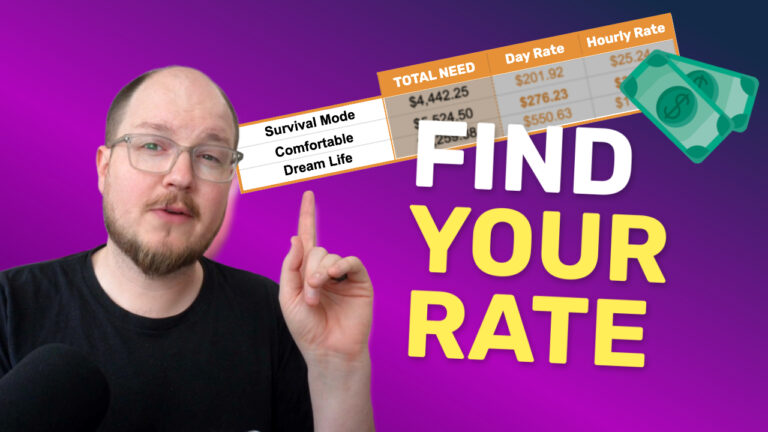We’re going to evaluate the pros and cons of 3 popular pricing approaches and prepare you to evolve the way you charge clients, so you can grow your little squirt of a side gig into a beefy business that’s primed to blast off into sky high profits.
#1 – Pricing Per Hour

When most folks are just beginning their freelance journey they’ll choose this little guy as their starter pricing model. The benefits of using an hourly rate or day rate approach is that it’s pretty straightforward, it’s familiar (it’s probably how you’re getting paid right now)…. and that’s about it.
When you charge per hour, you tie (or chain) your income to the amount of time you actively spend providing a service.
This requires a bit more administrative work to track and report your hours
Which starts to create more of an employer/employee relationship with your clients, they look over your shoulder and make sure you are staying on task and not wasting their time
Which is fair. You shouldn’t waste their time. But you’re overemphasizing time spent over value delivered.
Does it really matter in the end how much time it takes you to satisfactorily solve your client’s problem? Isn’t it more valuable if you can finish the job faster? Have you ever paid to ship something overnight? Enough said.
When you charge per hour, you can get penalized for efficiency and it doesn’t fully account for your expertise.
Picassos are expensive

There’s a story that’s often told when people talk about this concept – It’s probably made up – but it gets the point across. I goes something like this: Pablo Picasso is sitting in a park, drawing. A woman recognizes the famous artist and walks over to watch him finish a quick sketch. She says, “I love it. You are so talented. Can I buy that from you?”
Picasso says, “Absolutely.” She asks, “How much?”
“$15,000”
The woman gasps. “Surely, you can’t be serious. That took you less than two minutes to draw!”
To which Picasso replies, “No madame. It took me my whole life.”
“…And don’t call me Shirley.”
Get it?
Your clients aren’t just buying a few hours of your time. They’re buying what you can accomplish for them with that time. How much time and money have you invested in acquiring and honing your skills and wisdom so you can do what you do at the level you do it? How much time are you spending on the back office work, maintaining your business, tracking your time and sending invoices? For every hour you spend serving your clients – there are many, many more hours packed inside of that that people are directly benefiting from.
Upgrade your Hourly Rate
You can add margin to your rate to accommodate for the additional time and money you spend on marketing and maintaining your business. And yes, you can set a minimum service call fee or sell blocks of hours so you’re not clocking in for just a few minutes sending an invoice for less than the cost of the paper it’s printed on. And yes, you can raise rates as you gain more experience and confidence in the value you can pack into a certain amount of time. Don’t get me wrong, you can price by the hour and be very profitable.
But you might be able to get profitable faster with pricing method #2….
#2 Price Per Project (or Other Deliverable)

When you price per hour you need to be careful that you aren’t overemphasizing time spent over the value delivered, right? So what if we didn’t talk about time at all and focus on what you will actually do for your clients. I’m going to build you a website. Or bake you a cake. Or mow your lawn.
We’ll discuss timeframes and deadlines, but it ultimately doesn’t matter to the client how much of my time it takes to finish the job. They paid money for a thing, and they will get the thing.
The pros of this method are that you can charge your clients a flat fee for a service (you don’t have to track your time!), you know up front what your getting paid for the job, and your clients know up front what to expect.
Also (and arguably the most important benefit), if you work efficiently and develop systems to help you complete the project in less time – you’re not going to get penalized. In fact, you’ll get rewarded.
As for the cons: It’s risky. If you underestimate the time and energy it will take to complete a project, you can end up giving away a lot of time for free.
Protect yourself from Scope Creep
Scope creep is real. If your unfamiliar with the term, it’s when a customer’s requirements change and increase after a project has already started.
“We’d like to add one more page to the website, and just a couple online forms….. and do you know how to mint NFTs? We heard those things are cool.”
“Is it too late to add a 4th tier to the wedding cake? Shaped like a Red-eared Strider? My pet turtle Durston passed away and we’d like to honor him during the reception.”
Scope creep is natural and not necessarily bad. People change their minds about things and you should allow your customers to make adjustments to their order. But there should be no doubt in anybody’s mind that more work means more money.
If you adopt per project pricing, you must set clear expectations, define the terms, and get things in writing.
“You get two rounds of revisions. After that it’s an hourly rate or I send a new quote for the additional work. 4-tier cakes start at $700. Custom animal shapes are an additional 25%…. Or you know what? I don’t do turtles.”
You always have the option to say no, guide your clients to another solution, and protect your time.
Productizing Your Services
Project based pricing is a gateway to productizing your services – creating even more efficiency in your business.
Instead of drawing up a custom quote for each job, you can hand your clients a menu (menu graphic) of the core services you offer. You’ve standardized your process, you know you have the materials on hand, you know how much time it will take you to implement, and you know it’s delicious and it’s going to solve your customers problem. Or maybe it won’t. If your customer is in the market for lobster tail and you sell hamburgers, don’t reinvent and overextend yourself for one person. It’s just going to cause frustration for both parties, and neither of you are going to get as much value as you’d like out of the gig.
We’re kinda getting off on a rabbit trail. But the main concept here is that with project or deliverable based pricing, you are able to spend less time actively working while still fully serving your clients.
But it bears repeating, you need to set realistic expectations and manage your time well – underpromise and over-deliver – or else you run the risk of spending more time actively working and completely blow your profit margins.
So we’ve gone from focusing on time, to focusing on deliverables… but we’re still limiting our thinking and our clients thinking to the cost of the thing or the short term outcome they are receiving. There’s another stage in this evolutionary chain.
#3 Value-based Pricing

If someone is considering hiring you for a job, they don’t just want your time, they don’t even want the website, or the cake, or the mowed lawn. Not ultimately. They want what those things will do for them.
What would you get by paying someone else to mow your lawn? Short grass, yes, but perhaps pain avoidance (they don’t have to get sweaty doing a job they don’t like)? Perhaps a reputation amongst their neighbors? How about time? And how much is that worth? Well, that’s going to vary. Personally, I don’t mind mowing the lawn – and half the time my kids insist on doing it for me – I usually have to do it again when their done, but it’s a nice time to be outside and listen to a podcast.
But if I was an incredibly busy high powered orthodontist with bad knees and an obsession with keeping things straight – I’d probably be willing to hire a professional landscaping service to take that burden off my plate especially if they can do those cool stripey patterns on my lawn.
What do my clients get by hiring me to build them a website? They get a nice website, yes. But why do they want a website in the first place? What is that going to do for their business? Attract more visitors, improve the perception of their products and services, convert more leads into paying customers, and make more money. When people pay me to build them a website, there’s an expectation that they will get a return on their investment. They’ll make their money back and then some.
I’m drawing directly from Chris Do, the award winning designer and founder of The Futur – an educational platform for creative professionals. Check out his stuff. It is packed with value, and it introduced me to this concept of value-based pricing.
Watch some of his workshops and you’ll see him take people through the process of getting the client to unpack the true value of the project. In a nutshell, you need to learn about their business, and calculate the extra revenue they expect to generate (or alternatively, how much money they hope to save or how much risk they hope to avoid) as a direct result of this project. And then make a proposal:
“You sell $100,000 in widgets every month. And based on your current conversion rates, if we can increase traffic by 30% and improve your conversions on top of that, we’re looking at an extra $400,000 annually. If I can guarantee you that you will meet or exceed your traffic and conversion goals, and I come back to you with a proposal for under $40K, would you be ready to move forward?”
You keep the focus on everything they stand to gain, and then essentially ask if they’d be willing to pay you $10 for you to give them a $100 bill. And then you put in the work; you take however long it takes to do what it takes to help them achieve the end result you’re selling them.
But I will say, the way Chris presents value based pricing probably isn’t going to work for many situations. It is really hard to sell unless you have a strong reputation in your industry and people are willing to pay a premium to work with you.

I don’t currently use the value-based pricing model – I’m not sure I ever will, at least not in it’s purest form – But I’m trying to apply a value-based pricing mindset to the models I do use. And I’d encourage you to do the same. Take time to understand what your work is actually worth to your clients. And then give yourself permission to gussy up your hourly rate, slap some shades on that Squirtle. Add some more padding to your project estimate. If you’re committed to delivering value for your customers, you’re worth every penny.
I have my own insecurities and limiting beliefs regarding pricing that I’m currently working through. It’s one of the reasons I’ve been focusing on pricing recently. In my last video, I walked viewers through how to calculate their personal hourly rate – What they need to make in order to provide for yourself and a your family and maintain your desired lifestyle. But that’s baseline. That’s what you pay yourself out of your business. Your clients need to pay your business much more than that, and you need to fight back against your own tendencies to undervalue yourself.
And I’ll give some more ammunition and help you overcome common obstacles and objections regarding pricing in this video right here.


